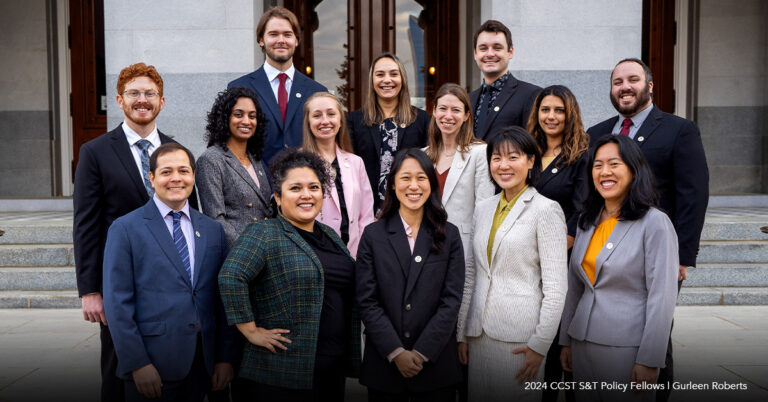Update: Applications for the CCST Science & Technology Policy Fellowship Have Closed
Cal Poly President Warren Baker Provides Leadership for CSU STEM Teacher Initiative
May 5, 2008 | CCST Newsroom | Contact: M. Daniel DeCillis
For the past several years, the California State University system (CSU), the largest teacher preparation system in California, has been focusing on increasing the quantity and quality of K-12 math and science teachers it produces, through its Mathematics and Science Teacher Initiative (MSTI). CSU committed to doubling its math and science teacher production from 750 to 1,500 by 2010. Three years after announcing the MSTI program, significant progress has been made.
CSU is meeting its MSTI goals through comprehensive recruitment efforts, new credential pathways, financial support and incentives, community college transfer programs, internet supported instruction and partnerships with government and industry labs to provide research internships. Over the past 4 years, CSU has achieved a 68 percent increase in the number of math and science teachers it produces, graduating 1,289 credential candidates in 2006-07. Nearly half of these teachers go on to teach in urban schools, and nearly three quarters in schools with high numbers of students in poverty.
President Warren Baker, of California Polytechnic State University, San Luis Obispo (Cal Poly), has taken a leadership role for the system’s efforts. “At Cal Poly we recognize the vital importance of mathematics and science education,” said President Baker. “We have taken an active role in identifying the challenges facing math and science education, through our participation in the CSU’s MSTI program, through support for CCST’s Critical Path Analysis studies, and through engagement at the national level in the Business-Higher Education Forum’s (BHEF) STEM education initiative.”
The CSU Math Science Initiative began in 2005 through a planning process involving all of its 23 campuses. The seven-part action plan is focused on meeting “one goal through diverse pathways,” with each campus committed to a specific plan based on regional needs and characteristics that identifies a numerical goal for increased credential production and specifies how it will be reached.
At Cal Poly, President Baker has taken the lead in the start-up of five programmatic initiatives that are envisioned to be systemwide and indeed statewide in their ultimate reach.
The first is a summer research internship program for pre-service and early career teachers, conducted in partnership with federal laboratories. This summer, 41 aspiring and early career science and math teachers will be participating in on-site, multi-week internships, providing mentored research experiences. Participating federal laboratories in summer 2008 include Lawrence Livermore National Laboratory, Lawrence Berkeley National Laboratory, Sandia/California, the Stanford Linear Accelerator, and NASA Ames. In future years Cal Poly and the CSU plan to increase the number of internships, through collaboration with federal, state, university and industry lab partners.
“Providing teachers with the opportunity to participate as interns in research laboratories is extremely valuable in terms of the hands-on laboratory experience, the sense of connection with the scientific community, and the opportunity to take these experiences back into the K-12 classroom” said Baker. The expansion of these programs follows on a joint meeting held last Spring with CCST Federal Laboratory Affiliates and higher education officials from CSU and UC.
Cal Poly and CSU are also promoting development of “learn by doing” laboratory facilities for pre-service and in-service K-12 STEM teachers, modeled on the successful Hands-On Science Laboratory at CSU-Chico; training institutes for K-12 administrators and school board members, focusing specifically on science and math education needs; a hybrid teacher education program dubbed “Poly Teach”, which includes online coursework as part of the teacher preparation pathway; and a fellowship program for aspiring teachers, which is being organized at the system level.
“The development of alternative pathways is a priority for the CSU initiative, but the challenge is to ensure that these alternatives maintain the same high standards present in the traditional teacher education programs offered by CSU,” said Baker. “Hybrid programs such as Poly Teach, which integrate high-tech alternatives with standard coursework, are proving to be valuable alternatives.”
The CSU efforts are just part of a long-term process, however. As CCST noted in the 2007 Critical Path Analysis, even the ambitious goals of CSU’s Math and Science Teacher Initiative, and the equivalent at UC, may not meet the needs of California’s teacher workforce.
“Clearly, improving the preparation and professional development of our science and math teachers is something that requires a long-term approach,” said Baker. “We’re just at the beginning.”






